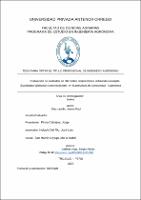Evaluación de sustratos en diferentes proporciones utilizando eucalipto (Eucalyptus globulus) como indicador, en la provincia de Contumazá - Cajamarca
Abstract
Esta investigación se desarrolló en el caserío de Silacot, distrito y provincia de Contumazá, departamento de Cajamarca. Los objetivos fueron evaluar la influencia de las distintas combinaciones de sustratos y evaluar el comportamiento de las plantas ante el uso de arena de cerro o río como componente del sustrato, teniendo como indicador plantas de eucalipto variedad globulus en la fase de vivero. El diseño usado fue el de bloques complemente al azar con 240 plantas distribuidas en 15 tratamientos con cuatro repeticiones y cuatro plantas por unidad experimental. De los 15 tratamientos 6 tuvieron combinaciones diferentes de arena, tierra negra y tierra agrícola (3 con arena de cerro y 3 con arena de río) 5 tratamientos con un factor limitante (arena de cerro o río, tierra negra o tierra agrícola) y 4 tratamientos 100% de un solo componente. Se evaluó el número de hojas, la altura y el diámetro de la base del tallo (DBT) de forma quincenal durante cuatro meses, Al finalizar la fase de campo se procedió a cosechar las plantas y evaluar la masa fresca de la parte aérea y radicular. Después de organizar los datos obtenidos se hizo interactuar las variables para evaluar indicadores de calidad como índice de Dickson, índice de esbeltez, relación de la parte aérea con la parte radicular, balance hídrico de la planta y porcentaje de lignificación. Se realizó un análisis de varianza donde las diferencias eran significativas, se realizó una prueba de agrupación por el método de LSD de Fisher con una confianza del 95%. Los resultados obtenidos muestran que ningún tratamiento tiene los mejores resultados para todas las variables. Sin embargo, el tratamiento L (50% tierra agrícola + 50% de tierra negra) obtuvo el primer lugar en las variables: Número de hojas (23.750 hojas), peso fresco aéreo (6.756 g), peso seco total (6.604 g) y peso seco aéreo. (2.863 g). El tratamiento G (15% arena de cerro + 50% tierra agrícola + 35% tierra negra) mostró los mejores resultados para las variables: DBT (3.373 mm), peso seco radicular (0.7788 g) e índice de Dickson (0.33808). Para la variable altura el tratamiento B (20% arena de río + 40% tierra agrícola + 40% tierra negra) obtuvo matemáticamente el mejor resultado (23.575 cm). Se comparó en parejas si existían diferencias estadísticas significativas al utilizar arena de río o cerro donde se pudo determinar que no existe diferencia significativa en ninguna de las parejas evaluadas en las variables: DBT, altura y peso seco aéreo. En las variables peso fresco total y peso fresco aéreo de los 6 pares evaluados dos muestran diferencias estadísticas significativas favorables a la utilización de arena de río mientras que, para el número de hojas, peso seco total, radicular e índice de Dickson al menos una de las 6 parejas evaluadas mostró diferencias estadísticas favorables a la utilización de arena de cerro. Según el análisis económico la arena de cerro es 33.3% más barata que la arena de río. This research was carried out in the Silacot hamlet, district and province of Contumazá, department of Cajamarca, the objectives were to evaluate the influence of the different combinations of substrates and to evaluate the behavior of the plants when using sand from a hill or river as a component. of the substrate, having as an indicator eucalyptus plants of the globulus variety in the nursery phase. The design used was the complete randomized block with 240 plants distributed in 15 treatments with four repetitions and 4 plants per experimental unit. Of the 15 treatments, 6 had different combinations of sand, black earth and agricultural earth (3 with sand from the hill and 3 with sand from the river) 5 treatments with a limiting factor (sand from the hill or river, black earth or agricultural earth) and 4 100% single component treatments. The number of leaves, the height and the diameter of the stem base (DBT) were evaluated biweekly for four months. At the end of the field phase, the plants were harvested and the fresh mass of the aerial and root parts was evaluated. After organizing the data obtained, the variables were interacted to evaluate quality indicators such as Dikson's index, slenderness index, relationship of the aerial part with the root part, water balance of the plant and percentage of lignification. An analysis of variance was performed and where the differences were significant, a grouping test was performed using Fisher's LSD method with a confidence of 95%. The results obtained show that no treatment has the best results for all variables, however treatment L (50% agricultural land + 50% black earth) obtained first place in the variables: Number of leaves (23,750 leaves), fresh weight aerial (6.756 g), total dry weight (6.604 g) and aerial dry weight (2.863g). Treatment G (15% hill sand + 50% agricultural land + 35% black earth) showed the best results for the variables: DBT (3.373 mm), root dry weight (0.7788 g) and Dickson index (0.33808). For the height variable, treatment B (20% river sand + 40% agricultural land + 40% black earth) mathematically obtained the best result (23,575 cm). It was compared in pairs if there were significant statistical differences when using river or hill sand where it could be determined that there is no significant difference in any of the pairs evaluated in the variables: DBT, height and aerial dry weight. In the variables total fresh weight and aerial fresh weight of the 6 pairs evaluated, two show significant statistical differences favorable to the use of river sand while, for the number of leaves, total dry weight, root weight and Dickson index, at least one of the 6 pairs evaluated showed statistical differences favorable to the use of hill sand. According to the economic analysis, sand from the hill is 33.3% cheaper than sand from the river.
Collections
- Ingeniería Agrónoma [107]


